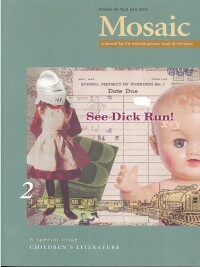Issue 34.2
Overview

Special Issue: Children's Literature
Published: June 2001
View the issue introduction or see the issue summary and contents below.
12 essays, totalling 208 pages
$17.95 CAD
This special issue of Mosaic contains twelve essays that explore aspects unique to the reading, writing, and meaning of children’s literature from around the world. While the imaginary is relevant to most of these essays, it is considered in different ways. A number of the essays are particularly interested in context (space, place, and time): sometimes real, sometimes not. Some of these essays focus on historic and cultural influence, while others focus more on the process of growing up. Additionally, four of the essays engage with specifically feminist critiques.
Private Places on Public View: David Wiesner’s Picture BooksPerry Nodelman While the illustrations in David Wiesner’s picture books evoke similar-looking worlds, the books tell stories that belong to different genres—or so literary theory suggests. After exploring how the similarities of these pictures challenge that theory and expose some of its assumptions, the author proposes that the books and the theories in question both celebrate and undermine the liberating potential of fantasy. | |
Why Anne Makes us Dizzy: Reading Anne of Green Gables from a Gender PerspectiveJulia McQuillan and Julie Pfeiffer Critics struggle to understand how gender influences authors and readers, focussing usually on gender as something that exists purely in individuals. These authors read Anne of Green Gables to demonstrate how what social scientists call “a gender perspective” gives us new insights into literary texts. | |
“For I am But a Girl”: Female Power in Ford Madox Ford’s “The Brown Owl”Lori M. Campbell This essay brings a feminist perspective to bear on the fairy-tale princess character type, both in classic tales and in Victorian literary fantasy. The essay argues that in “The Brown Owl” Ford Madox Ford’s Ismara exemplifies the problematic state of gender roles in late-nineteenth-century society. | |
“Secret Men’s Business”: New Millennium Advice for Australian BoysSharyn Pearce This essay offers a feminist critique of theories of the mythopoetic men’s movement involved in the current debate about “boys in crisis.” The essay argues that texts such as Secret Men’s Business, by Australian author John Marsden, hinder rather than help boys and gender relations. | |
“Said a Bird in the Midst of a Blitz…”: How World War II Created Dr. SeussPhilip Nel This essay examines the effect that Dr. Seuss’s experience as a cartoonist for the newspaper PM had on his later career as a writer of children’s books. While Richard Minear’s Dr. Seuss Goes to War: The World War II Editorial Cartoons of Theodor Seuss Geisel situates these cartoons historically, this essay examines how the war shaped Dr. Seuss. | |
Western Novels as Children’s Literature in Nineteenth-Century FranceMark Wolff From 1850 to 1889, French writers and publishers produced large numbers of-western novels that were eventually considered children’s literature. An analysis of western novel titles shows how this literature objectified le Nouveau Monde and subjected it to a mode of vision imposed on children. | |
Bosco and Le Clézio: Elemental InitiationsLynn Penrod This essay is a reading of two short texts, Henri Bosco’s L’Enfant et la rivière and Jean-Marie Gustave Le Clézio’s Celui qui n’avait jamais vu la mer, illustrating the close link between them in terms of Gaston Bachelard’s writing in Water and Dreams: An Essay on the Imagination of Matter. | |
Childhood Bound: In Gardens, Maps, and PicturesSusan E. Honeyman This essay considers the ways that writers have territorialized childhood by creating fantasy worlds and friendly spaces for fictional children. It draws for the most part from children’s literature, with brief references to “grown-up” works that further exemplify adult motives in constructing childhood spaces. | |
Constructing the Nation: Eighteenth-Century Geographies for ChildrenJohanna M. Smith Because books of geography construct imaginative topographies, they instrumental in nation building. Geographies for children written in the eighteenth century demonstrate the ways that Britain imagined itself—in contrast to and conflict with Others, as a predominantly commercial nation—and they demonstrate also the gendered and racial fissures in such imagined communities. | |
Adolescence, Imperialism, and Identity in Kim and Pegasus in FlightNicole E. Didicher Adults writing for adolescents inevitably use imperialist discourse to influence their readers’ maturation. Kipling’s Kim uses an existing imperialist society to present the protagonist’s establishment of his psychosocial identity, while McCaffrey’s Pegasus in Flight adapts similar imperialist patterns to a more politically sensitive context. | |
Romantic Archetypes in Peppermints in the ParlorVirginia Brackett This analysis of romantic archetypes in Wallace’s Peppermints in the Parlor draws from Carl Jung, Northrop Frye, and Joseph Campbell while also reflecting upon the developmental theories of Jean Piaget, Alleen Pace Nilsen, and Kenneth L. Donelson. It argues that, although unaware of the origin of its metaphors, children enjoy mythologically based literature. | |
Nontraditional Adoption in Progressive-Era Orphan NarrativesClaudia Nelson This essay examines representations of adoption by single women in American texts written between 1890 and 1918. The narratives considered here take a polysemic approach to the spinsters who figure in them, potentially subverting both conservative and radical visions of marriage and motherhood. |